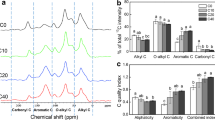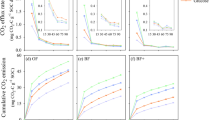Abstract
The mechanisms of soil pH change after the addition of organic matter to soil are not fully understood. The aim of this study was to investigate changes in pH after addition of carbon compounds over a 60-d incubation period. Seven organic compounds commonly found in plant residues (acetic acid, malic acid, citric acid, benzoic acid, ferulic acid, glucosamine hydrochloride and glucose) were selected based on the number and type of functional groups, and added at 0.5 mg C·g−1 soil to two soils differing in initial pH. Addition of organic acids (R-COOH) immediately decreased pH. The magnitude of the pH decrease depended on dissociation constant of the acid and the initial soil pH. In subsequent incubation, pH was slowly returned to original levels as organic anions were mineralized, consuming H+ ions. Glucose which contains hydroxyl (R-OH) group did not alter soil pH. However, carboxyl (R-COOH) and amine (R-NH2) groups changed pH significantly. Soil respiration was also increased by the addition of C compounds. Cumulative respiration was higher in soil with malic acid, citric acid, ferulic acid and glucose than with other compounds. The addition of glucose, citric acid and malic acid resulted in priming as cumulative respiration was greater than the actual amount of C added.
Access this chapter
Tax calculation will be finalised at checkout
Purchases are for personal use only
Similar content being viewed by others
References
Brady NC, Weil RR (2002) The Nature and Properties of Soils. New Jersey, Prentice Hall
Butterly CR, Bunemann EK (2009) Carbon pulses but not phosphorus pulses are related to decreases in microbial biomass. Soil Biol. Biochem. 41: 1406–1416
Essington ME (2004) Soil and Water Chemistry: An Integrative Approaches. Florida, CRC press LLC.
Ritchie GSP, Dolling PJ (1985) The role of organic matter in soil acidification. Aust. J. Soil Res. 23: 569–576
Tang C (2004) Causes and management of subsoil acidity. 3rd Australian New Zealand Soils Conference. University of Sydney, Australia, www.regional.org.au/au/assi/
Tang C, Yu Q (1999) Impact of chemical composition of legume residues and initial soil pH on pH change of a soil after residue incorporation. Plant Soil 215: 29–38
Xu JM, Tang C, et al. (2006) The role of plant residues in pH change of acid soils differing in initial pH. Soil Biol. Biochem. 38: 709–719
Author information
Authors and Affiliations
Corresponding author
Editor information
Editors and Affiliations
Rights and permissions
Copyright information
© 2010 Zhejiang University Press, Hangzhou and Springer-Verlag Berlin Heidelberg
About this paper
Cite this paper
Rukshana, F., Butterly, C.R., Xu, J., Baldock, J.A., Tang, C. (2010). Carbon Compounds Differ in Their Effects on Soil pH and Microbial Respiration. In: Xu, J., Huang, P.M. (eds) Molecular Environmental Soil Science at the Interfaces in the Earth’s Critical Zone. Springer, Berlin, Heidelberg. https://doi.org/10.1007/978-3-642-05297-2_97
Download citation
DOI: https://doi.org/10.1007/978-3-642-05297-2_97
Publisher Name: Springer, Berlin, Heidelberg
Print ISBN: 978-3-642-05296-5
Online ISBN: 978-3-642-05297-2
eBook Packages: Earth and Environmental ScienceEarth and Environmental Science (R0)




